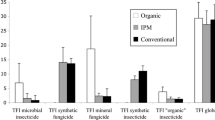Summary
Foraging by migratory pine siskins in an apple orchard infested with varying densities of winter moth was observed, and winter moth mortality in the presence and absence of birds was recorded. Time spent foraging in a tree and number of birds foraging per tree was positively related to larval density but number of larvae removed per leaf cluster or per unit time was not. Level of defoliation was a better predictor of the number of clusters searched per tree than was prey density. Despite poor predictability in allocation of search effort with respect to prey density, siskins acted as a source of strong compensatory mortality on the winter moth population.
Similar content being viewed by others
References
Altmann J (1974) Observational study of behavior: sampling methods. Behaviour 49:227–267
Benson JF (1973) Some problems of testing for density-dependence in animal populations. Oecologica (Berlin) 13:183–190
Betts MM (1955) The food of titmice in oak wookland. J Anim Ecol 24:282–323
Dowden PB, Carolin VP, Dirks CO (1950) Natural control factors affecting the spruce budworm in the Adirondacks during 1946–1948. J Econ Ent 43:774–783
Embree DG (1965) The population dynamics of the winter moth in Nova Scotia, 1954–1962. Mem Ent Soc Can 46:1–57
Gardner DR, Bailey JR (1975) Methoxychlor: its effects on environmental quality. National Research Council of Canada, Canada, Rep N 14102, Ottawa
Getty, T, Krebs JR (1985) Lagging partial preferences for cryptic prey: a signal detection analysis of great tit foraging. Am Nat 125:39–60
Gillespie DR, Finlayson T, Tonks NV, Ross DA (1978) Occurrence of the winter moth, Operophtera brumata (Lepidoptera: Geometridae), on southern Vancouver Island, British Columbia. Can Ent 110:223–224
Godfrey WE (1966) The birds of Canada. Nat Mus Can Bull 203:1–428
Hardee DD, Huddleston EW, Gyrisco GG (1963) Initial deposit and disappearance rates of various insecticides as affected by forage crop species. J Econ Ent 56:98–101
Heinrich B, Collins SL (1983) Caterpillar leaf damage, and the game of hide-and seek with birds. Ecology 64:592–602
Holling CS (1965) The functional response of predators to prey density and its role in mimicry and population regulation. Mem Ent Soc Can 45:1–60
Ito Y (1972) On the methods for determining density-dependence by means of regression. Oecologia (Berlin) 10:347–372
Krebs JR (1978) Optimal foraging: decision rules for predators. In: Krebs JR, Davies NB (eds) Behavioural Ecology: An Evolutionary Approch, Sinauer Associates Inc, Sunderland, pp 23–63
Krebs, JR, Stephens DW, Sutherland WJ (1983) Perspectives in optimal foraging. In: Brush AH, Clark Jr GA (eds), Perspectives in Ornithology, Cambridge University Press, Cambridge, pp 165–216
MacArthur RH, Pianka ER (1966) On optimal use of a patchy environment. Am Nat 100:603–609
Martindale S (1982) Nest defense and central place foraging: a model and experiment. Behav Ecol Sociobiol 10:85–90
Milinski M, Heller R (1978) Influence of a predator on the optimal foraging behaviour of sticklebacks (Gasterosteus aculeatus L.). Nature 275:642–644
Morris RF (1963) Predation and the spruce budworm. Mem Ent Soc Can 31:244–248
Morris RF, Cheshire WF, Miller CA, Mott DG (1958) The numerical response of avian and mammalian predators during a gradation of the spruce budworm. Ecology 39:487–494
Otvos IS (1979) The effects of insectivorous bird activities in forest ecosystems: an evaluation. In: Dickson JG, Conner RN, Fleet RR, Kroll JC, Jackson JA (eds) The Role of Insectivorous Birds in Forest Ecosystems. Academic Press, New York, pp 341–347
Roland J (1986) Parasitism of winter moth in British Columbia during buildup of its parasitoid Cyzenis albicans: attack rate on oak versus apple. J Anim Ecol (in press)
Royama T (1984) Population dynamics of the spruce budworm (Choristoneura fumiferana). Ecol Monog 54:429–462
Schultz TD (1983) Opportunistic foraging of Western Kingbirds on aggregations of tiger beetles. Auk 100:496
Sokal RR, Rohlf FJ (1969) Biometry. The Principles and Practice and Statistics in Biological Research. WH Freeman and Co, San Francisco
Torgersen TR, Campbell RW (1982) Some effects of avian predators on the western spruce budworm in North Central Washington. Env Ent 11:429–431
Varley GC (1963) The interpretation of change and stability in insect populations. Proc R Ent Soc Lond (C) 27:52–57
Williamson GD (1981) Insect Liberations in Canada. Parasites and predators 1979. Agric Can Res Br
Author information
Authors and Affiliations
Rights and permissions
About this article
Cite this article
Roland, J., Hannon, S.J. & Angela Smith, M. Foraging pattern of pine siskins and its influence on winter moth survival in an apple orchard. Oecologia 69, 47–52 (1986). https://doi.org/10.1007/BF00399036
Received:
Issue Date:
DOI: https://doi.org/10.1007/BF00399036




